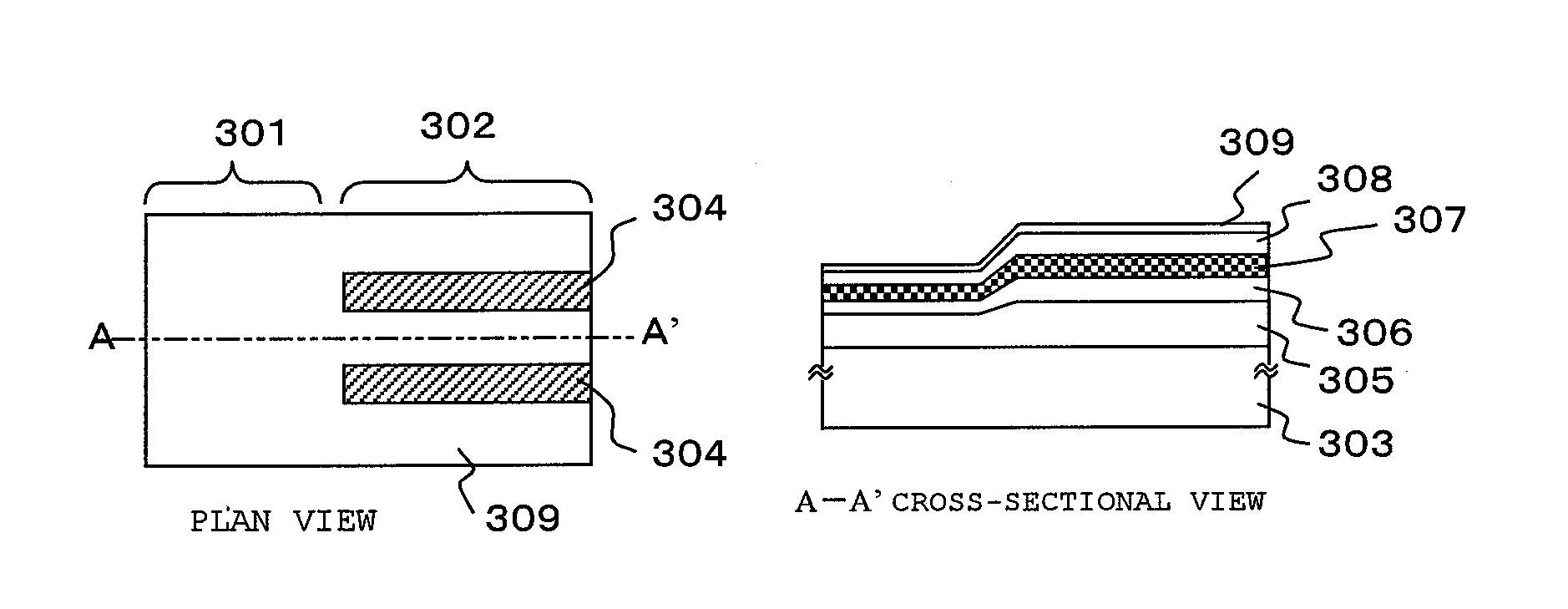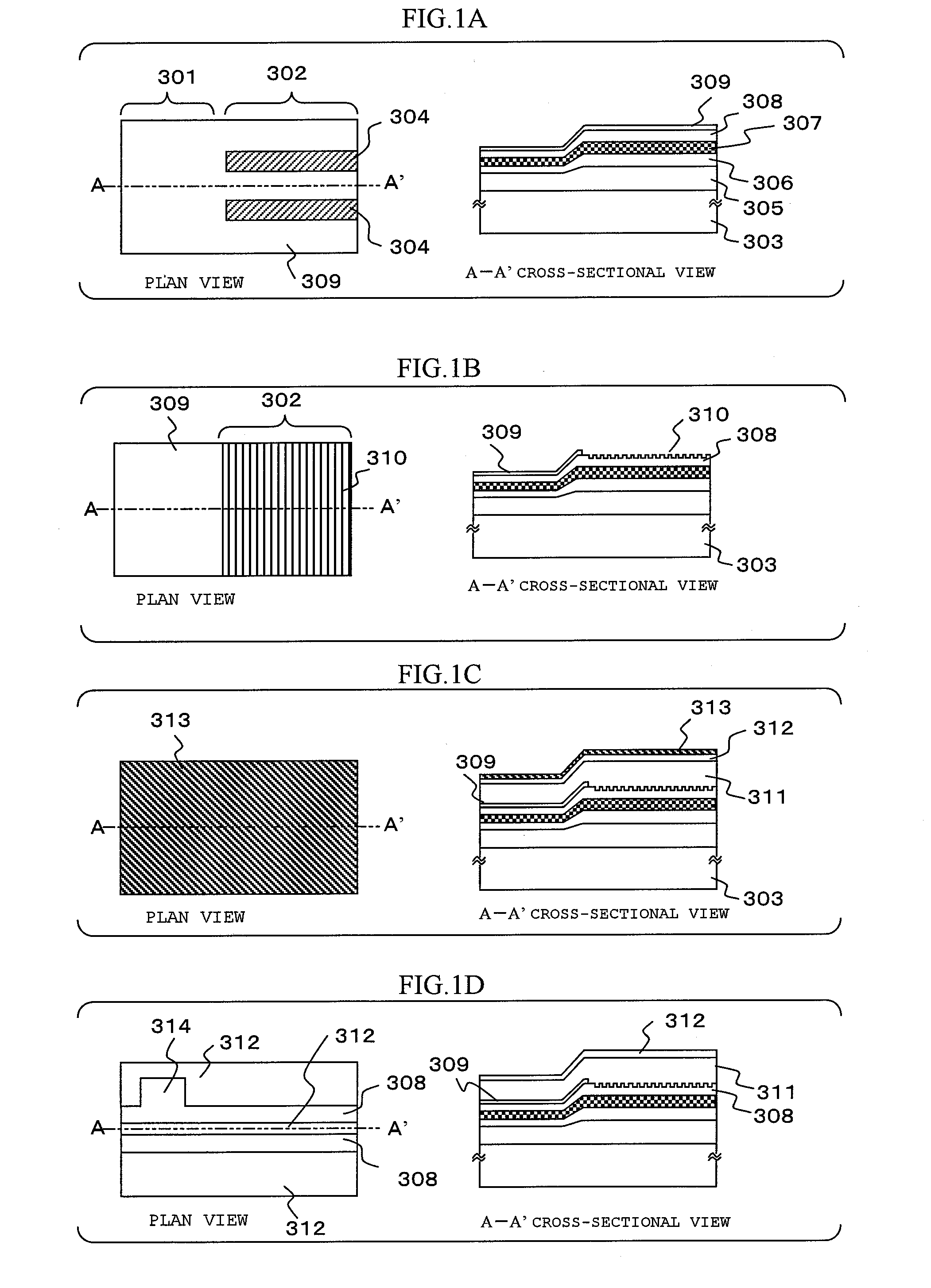Semiconductor optical device and optical transmission module
a technology of semiconductor optical devices and optical transmission modules, which is applied in the direction of semiconductor lasers, nanotechnology, lasers, etc., can solve the problems of difficult mass-production of semiconductor optical devices, difficult to stably provide materials, adversely affecting the modulation band of ea modulators, etc., to facilitate the design of capacitors, reduce time and cost, and reduce the condition of crystal growth
- Summary
- Abstract
- Description
- Claims
- Application Information
AI Technical Summary
Benefits of technology
Problems solved by technology
Method used
Image
Examples
first embodiment
[0040] A first embodiment of the invention will be described. Referring to FIGS. 1A to 1D and FIGS. 2E to 2G, a description will be given below of a method of fabricating an EA / DFB integrated laser in which an EA modulator portion 301 takes a polyimide-resin-buried ridge waveguide structure and a laser portion 302 takes a ridge waveguide structure having air around a mesa. FIGS. 1A to 1D and FIGS. 2E to 2G each show a plan view and a cross-sectional view.
[0041] First, SiO2 films 304 are formed on an n-type semiconductor substrate 303 by T-CVD, and the SiO2 films 304 sandwiching that region of a laser portion 302 equivalent to a mesa are patterned. With the SiO2 films 304 as masks, an n-type InP buffer layer 104, an n-type InGaAsP lower guide layer 306, an MQW 307 having a well / barrier layer of InGaAsP, a p-type InGaAsP upper guide layer 308, and a p-type InP cap layer 309 are grown in order by selective growth called MO-CVD (first multilayer growth: FIG. 1A)
[0042] Thereafter, the ...
second embodiment
[0057]FIGS. 3A to 3C are diagrams for explaining a second embodiment of the invention. FIG. 3A is a plan view, FIG. 3B is a cross-sectional view along A-A′, and FIG. 3C is a cross-sectional view along B-B′.
[0058] The following description of the embodiment will be given of a case where an external modulator is a Mach-Zehnder modulator. Specifically, the embodiment is a semiconductor optical device which has the integration of a Mach-Zehnder modulator portion 401 having a polyimide-resin buried ridge waveguide structure, and a laser portion 402 having a ridge waveguide structure having air around the mesa.
[0059] This device can be fabricated through substantially the same processes as described in the foregoing description of the first embodiment. First, an n-type InP buffer layer 404, an n-type InGaAsP lower guide layer 405, an MQW 406 of InGaAsP, a p-type InGaAsP upper guide layer 407, and a p-type InP cap layer 408 are grown on an n-type InP substrate 403 in the first multilayer...
third embodiment
[0062]FIGS. 4A to 4C are diagrams for explaining a third embodiment of the invention. FIG. 4A is a plan view, FIG. 4B is a cross-sectional view along A-A′, and FIG. 4C is a cross-sectional view along B-B′.
[0063] The following description of the embodiment will be given of an EA / DFB integrated laser with a ridge waveguide structure which uses InGaAlAs for an MQW.
[0064] A feature of InGaAlAs lies in the fact that the band offset ΔEv of the valence-band is smaller and the band offset ΔEc of the conduction-band is larger than those of InGaAsP. That is, the use of InGaAlAs in the laser portion ensures sufficiently strong electron confinement and uniform hole injection, so that electrons do not easily leak from the MQW even at a high temperature, thus making it possible to ensure a stable operation over a wide temperature range.
[0065] The use of InGaAlAs in the EA modulator portion can sufficiently confine electrons even if confinement of holes is made weaker to improve the chirp chara...
PUM
 Login to View More
Login to View More Abstract
Description
Claims
Application Information
 Login to View More
Login to View More - R&D
- Intellectual Property
- Life Sciences
- Materials
- Tech Scout
- Unparalleled Data Quality
- Higher Quality Content
- 60% Fewer Hallucinations
Browse by: Latest US Patents, China's latest patents, Technical Efficacy Thesaurus, Application Domain, Technology Topic, Popular Technical Reports.
© 2025 PatSnap. All rights reserved.Legal|Privacy policy|Modern Slavery Act Transparency Statement|Sitemap|About US| Contact US: help@patsnap.com



